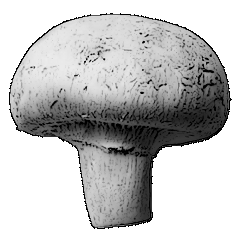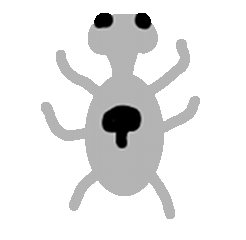Mushroom
<< ChickenBugs | GridworldTrailIndex | RockHound >>



Make a Mushroom Actor that will keep track of its age so that it will die (remove itself from the grid) after 4 steps.
Watch a Quicktime movie of it in action
Make a MushroomBug that will drop Mushrooms instead of Flowers, and die (remove itself from the grid) if it "eats" (moves to a location occupied by) a Mushroom.
- Make and test your
Mushroomclass - Make your
MushroomBug, and test that it drops Mushrooms, and has a booleanpoisonedfield andoriginalColorfield. - Override your MushroomBug's
canMove()method to record if was poisoned, and allow moving overMushroomobjects - Override your Mushroom's
move()method so it turns black if it is poisoned, and if it is already black removes itself from the grid. - See if you can further adapt your
move()method so that it drops aTombstone(of the MushroomBug's original color) instead of aMushroomwhen it removes itself from the grid. - See if you can get a hint from the
Flowerclass so that yourTombstoneis actually a darker version of the MushroomBug's original color.
MushroomBugRunner.java
import java.awt.Color;
import info.gridworld.actor.*;
import info.gridworld.grid.BoundedGrid;
import info.gridworld.grid.Location;
public class MushroomBugRunner
{
public static void main (String[] args)
{
ActorWorld myWorld = new ActorWorld();
myWorld.setGrid(new BoundedGrid<Actor>(4,5));
myWorld.setMessage("Mushroom Bug Runner");
myWorld.add(new Location(3,4), new Mushroom());
myWorld.add(new Location(0,2), new Rock());
myWorld.add(new Location(1,1), new MushroomBug());
MushroomBug greeny=new MushroomBug(Color.GREEN);
myWorld.add(new Location (1,0), greeny);
MushroomBug yellowy=new MushroomBug(Color.YELLOW);
yellowy.setDirection(Location.NORTHEAST);
myWorld.add(new Location(3,3), yellowy);
myWorld.show();
}
}
Get some ideas for the Mushroom from the Flower class. What would you do differently?
Flower.java
/*
* AP(r) Computer Science GridWorld Case Study:
* Copyright(c) 2005-2006 Cay S. Horstmann (http://horstmann.com)
*
* This code is free software; you can redistribute it and/or modify
* it under the terms of the GNU General Public License as published by
* the Free Software Foundation.
*
* This code is distributed in the hope that it will be useful,
* but WITHOUT ANY WARRANTY; without even the implied warranty of
* MERCHANTABILITY or FITNESS FOR A PARTICULAR PURPOSE. See the
* GNU General Public License for more details.
*
* @author Cay Horstmann
*/
package info.gridworld.actor;
import java.awt.Color;
/**
* A <code>Flower</code> is an actor that darkens over time. Some actors drop
* flowers as they move. <br />
* The API of this class is testable on the AP CS A and AB exams.
*/
public class Flower extends Actor
{
private static final Color DEFAULT_COLOR = Color.PINK;
private static final double DARKENING_FACTOR = 0.05;
// lose 5% of color value in each step
/**
* Constructs a pink flower.
*/
public Flower()
{
setColor(DEFAULT_COLOR);
}
/**
* Constructs a flower of a given color.
* @param initialColor the initial color of this flower
*/
public Flower(Color initialColor)
{
setColor(initialColor);
}
/**
* Causes the color of this flower to darken.
*/
public void act()
{
Color c = getColor();
int red = (int) (c.getRed() * (1 - DARKENING_FACTOR));
int green = (int) (c.getGreen() * (1 - DARKENING_FACTOR));
int blue = (int) (c.getBlue() * (1 - DARKENING_FACTOR));
setColor(new Color(red, green, blue));
}
}
Get some ideas for the MushroomBug from the Bug class. What methods do you need to override?
Bug.java
/*
* AP(r) Computer Science GridWorld Case Study:
* Copyright(c) 2005-2006 Cay S. Horstmann (http://horstmann.com)
*
* This code is free software; you can redistribute it and/or modify
* it under the terms of the GNU General Public License as published by
* the Free Software Foundation.
*
* This code is distributed in the hope that it will be useful,
* but WITHOUT ANY WARRANTY; without even the implied warranty of
* MERCHANTABILITY or FITNESS FOR A PARTICULAR PURPOSE. See the
* GNU General Public License for more details.
*
* @author Cay Horstmann
*/
package info.gridworld.actor;
import info.gridworld.grid.Grid;
import info.gridworld.grid.Location;
import java.awt.Color;
/**
* A <code>Bug</code> is an actor that can move and turn. It drops flowers as
* it moves. <br />
* The implementation of this class is testable on the AP CS A and AB exams.
*/
public class Bug extends Actor
{
/**
* Constructs a red bug.
*/
public Bug()
{
setColor(Color.RED);
}
/**
* Constructs a bug of a given color.
* @param bugColor the color for this bug
*/
public Bug(Color bugColor)
{
setColor(bugColor);
}
/**
* Moves if it can move, turns otherwise.
*/
public void act()
{
if (canMove())
move();
else
turn();
}
/**
* Turns the bug 45 degrees to the right without changing its location.
*/
public void turn()
{
setDirection(getDirection() + Location.HALF_RIGHT);
}
/**
* Moves the bug forward, putting a flower into the location it previously
* occupied.
*/
public void move()
{
Grid<Actor> gr = getGrid();
if (gr == null)
return;
Location loc = getLocation();
Location next = loc.getAdjacentLocation(getDirection());
if (gr.isValid(next))
moveTo(next);
else
removeSelfFromGrid();
Flower flower = new Flower(getColor());
flower.putSelfInGrid(gr, loc);
}
/**
* Tests whether this bug can move forward into a location that is empty or
* contains a flower.
* @return true if this bug can move.
*/
public boolean canMove()
{
Grid<Actor> gr = getGrid();
if (gr == null)
return false;
Location loc = getLocation();
Location next = loc.getAdjacentLocation(getDirection());
if (!gr.isValid(next))
return false;
Actor neighbor = gr.get(next);
return (neighbor == null) || (neighbor instanceof Flower);
// ok to move into empty location or onto flower
// not ok to move onto any other actor
}
}
